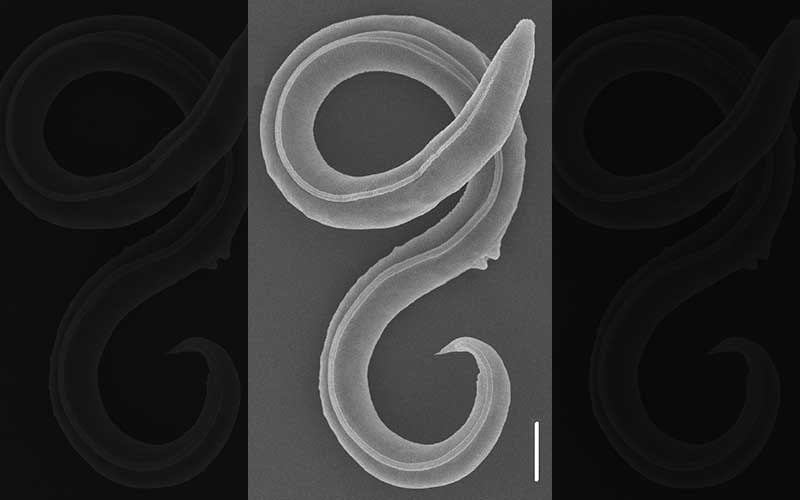 Siberian Permafrost
Siberian Permafrost
Siberian permafrost: Worm revived after 46,000 years
When Anastasia Shatilovich at the Institute of Physicochemical and Biological Problems in Soil Science RAS in Russia revived two frozen individual nematodes from a fossilized burrow in silt deposits in the Siberian permafrost, she and her colleagues were beyond excited.
After thawing the worms in the lab, a radiocarbon analysis of plant material from the burrow revealed that these frozen deposits, 40 meters below the surface, had not thawed since the late Pleistocene, between 45,839 and 47,769 years ago.
At the same time, the research group of Teymuras Kurzchalia at the MPI-CBG (Teymuras Kurzchalia is now retired) was already addressing the question of how larval stages of the nematode Caenorhabditis elegans survive extreme conditions. When the team heard about the permafrost nematodes, they immediately reached out for a collaboration with Anastasia Shatilovich.
Vamshidhar Gade, a doctoral student at that time in the research group of Teymuras Kurzchalia, started to work with the permafrost nematodes. “What molecular and metabolic pathways these cryptobiotic organisms use and how long they would be able to suspend life are not fully understood,” he says. Vamshidhar is now working at the ETH in Zurich, Switzerland.
The researchers in Dresden conducted a high-quality genome assembly of one of the permafrost nematodes in collaboration with Eugene Myers, Director Emeritus and research group leader at the MPI-CBG, the DRESDEN-concept Genome Center, and the research group of Michael Hiller, research group leader at that time at the MPI-CBG and now Professor of Comparative Genomics at the LOEWE-TBG and the Senckenberg Society for Nature Research. Despite having DNA barcoding sequences and microscopic pictures, it was difficult to determine whether the permafrost worm was a new species or not.
Philipp Schiffer, research group leader at the Institute of Zoology, co-lead of the incipient Biodiversity Genomics Center Cologne (BioC2) at the University of Cologne, and expert in biodiversity genomics research, joined forces with the Dresden researchers to determine the species and analyze its genome with his team. Using phylogenomic analysis, he and his team were able to define the roundworm as a novel species, and the team decided to call it “Panagrolaimus kolymaensis”. In recognition of the Kolyma River region from which it originated, the nematode was given the Latin name Kolymaensis.
By comparing the genome of Panagrolaimus kolymaensis with that of the model nematode Caenorhabditis elegans, the researchers in Cologne identified genes that both species have in common and that are involved in cryptobiosis.
To their surprise, most of the genes necessary for entering cryptobiosis in Caenorhabditis elegans so-called Dauer larvae were also present in Panagrolaimus kolymaensis.
The research team next evaluated Panagrolaimus kolymaensis's ability to survive and discovered that mild dehydration exposure before freezing helped the worms prepare for cryptobiosis and increased survival at -80 degrees Celsius.
At a biochemical level, both species produced a sugar called trehalose when mildly dehydrated in the lab, possibly enabling them to endure freezing and intense dehydration.
Caenorhabditis elegans larvae also benefited from this treatment, surviving for 480 days at -80 degrees Celsius without suffering any declines in viability or reproduction following thawing.
According to Vamshidhar Gade and Temo Kurzhchalia, “Our experimental findings also show that Caenorhabditis elegans can remain viable for longer periods in a suspended state than previously documented.
Overall, our research demonstrates that nematodes have developed mechanisms that allow them to preserve life for geological time periods.”
“Our findings are essential for understanding evolutionary processes because generation times can range from days to millennia and because the long-term survival of a species' individuals can result in the re-emergence of lineages that would otherwise have gone extinct,” concludes Philipp Schiffer, one of the authors who oversaw the study. Eugene Myers adds: “P. kolymaensis's highly contiguous genome will make it possible to compare this feature to those of other Panagrolaimus species whose genomes are presently being sequenced by Schiffer’s team and colleagues.” Philipp Schiffer is convinced that “studying the adaptation of species to such extreme environments by analyzing their genomes will allow us to develop better conservation strategies in the face of global warming.” Teymuras Kurzchalia says: “This study extends the longest reported cryptobiosis in nematodes by tens of thousands of years.”
Support Our Journalism
We cannot do without you.. your contribution supports unbiased journalism
IBNS is not driven by any ism- not wokeism, not racism, not skewed secularism, not hyper right-wing or left liberal ideals, nor by any hardline religious beliefs or hyper nationalism. We want to serve you good old objective news, as they are. We do not judge or preach. We let people decide for themselves. We only try to present factual and well-sourced news.






